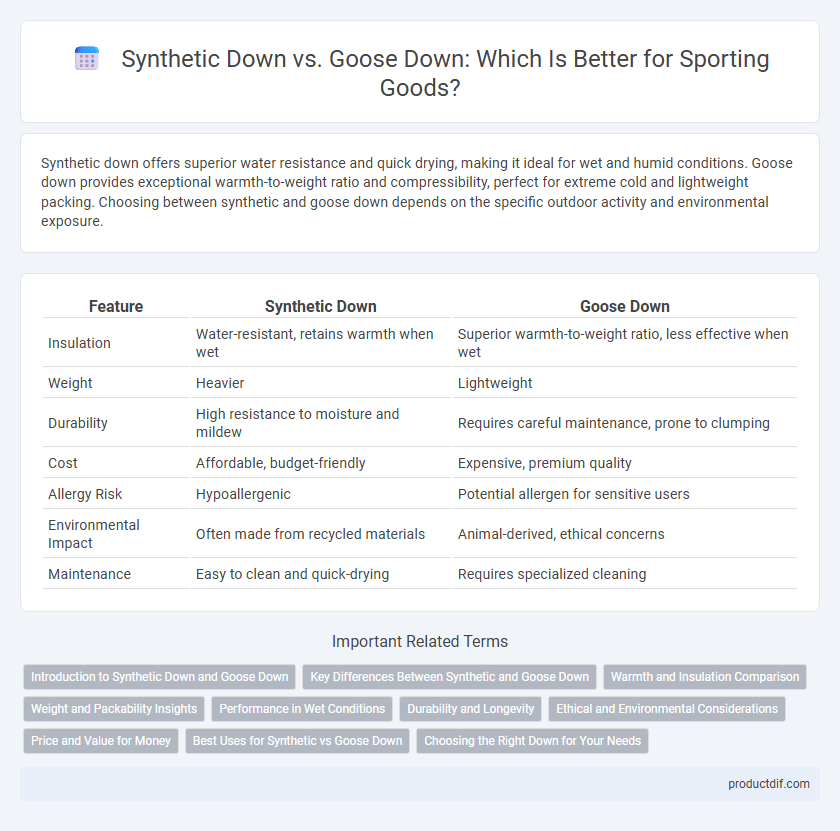Synthetic down offers superior water resistance and quick drying, making it ideal for wet and humid conditions. Goose down provides exceptional warmth-to-weight ratio and compressibility, perfect for extreme cold and lightweight packing. Choosing between synthetic and goose down depends on the specific outdoor activity and environmental exposure.
Table of Comparison
| Feature | Synthetic Down | Goose Down |
|---|---|---|
| Insulation | Water-resistant, retains warmth when wet | Superior warmth-to-weight ratio, less effective when wet |
| Weight | Heavier | Lightweight |
| Durability | High resistance to moisture and mildew | Requires careful maintenance, prone to clumping |
| Cost | Affordable, budget-friendly | Expensive, premium quality |
| Allergy Risk | Hypoallergenic | Potential allergen for sensitive users |
| Environmental Impact | Often made from recycled materials | Animal-derived, ethical concerns |
| Maintenance | Easy to clean and quick-drying | Requires specialized cleaning |
Introduction to Synthetic Down and Goose Down
Synthetic down, made from polyester fibers, offers water resistance and hypoallergenic properties ideal for outdoor gear. Goose down, sourced from the undercoating of geese, provides superior warmth-to-weight ratio and excellent compressibility. Both fill materials are widely used in jackets, sleeping bags, and bedding, with synthetic down excelling in wet conditions and goose down favored for its natural insulation and breathability.
Key Differences Between Synthetic and Goose Down
Synthetic down insulation uses polyester fibers designed to mimic the loft and warmth of natural goose down but retains insulating properties even when wet. Goose down, harvested from the undercoating of waterfowl, offers superior warmth-to-weight ratio and compressibility, making it extremely efficient for lightweight outdoor gear. Key differences include durability in moisture, hypoallergenic potential, and environmental impact, where synthetic down is less affected by water and easier to clean, while goose down provides unmatched insulation but requires careful maintenance.
Warmth and Insulation Comparison
Synthetic down insulation retains heat effectively even when wet, making it ideal for damp or snowy conditions, while goose down excels in loft and breathability, providing superior warmth-to-weight ratio in dry environments. Goose down clusters trap air more efficiently, resulting in higher thermal insulation and compressibility compared to synthetic fibers. However, synthetic down typically dries faster and maintains insulation performance after repeated use in moisture-prone sports like skiing or hiking.
Weight and Packability Insights
Synthetic down offers lighter weight and superior packability compared to traditional goose down, making it ideal for compact sporting gear. Its ability to retain insulation properties even when compressed ensures efficient storage without sacrificing warmth. Goose down, while highly insulating, tends to be bulkier and heavier, which may limit its convenience for lightweight or ultralight sporting applications.
Performance in Wet Conditions
Synthetic down insulation retains warmth effectively when wet, making it ideal for wet weather performance in outdoor sporting gear. Goose down, while superior in loft and warmth under dry conditions, loses insulating properties rapidly when damp due to its tendency to clump and absorb moisture. Advances in water-resistant treatments for synthetic down further enhance its reliability and durability in wet and humid environments.
Durability and Longevity
Synthetic down insulation offers superior durability and maintains loft even when wet, making it ideal for extended use in harsh outdoor conditions. Goose down, while providing unmatched warmth-to-weight ratio, tends to lose its insulating properties when exposed to moisture and requires careful maintenance to preserve longevity. Overall, synthetic down outperforms goose down in terms of lifespan and resilience, especially for active sporting goods exposed to variable weather.
Ethical and Environmental Considerations
Synthetic down offers a cruelty-free alternative to goose down, eliminating concerns about animal welfare and live-plucking practices commonly associated with traditional down production. Environmentally, synthetic insulation is often derived from recycled polyester, reducing landfill waste and reliance on virgin petroleum, while goose down, despite being biodegradable, involves resource-intensive farming and potential ecological impacts. Consumers prioritizing sustainability should weigh the lower carbon footprint and animal-friendly attributes of synthetic down against the natural biodegradability and thermal efficiency of ethically sourced goose down.
Price and Value for Money
Synthetic down offers a more affordable option compared to goose down while maintaining insulating properties suitable for various outdoor activities. Goose down typically provides superior warmth-to-weight ratio and durability, making it a higher-value investment for serious athletes and cold-weather enthusiasts. Budget-conscious buyers often find synthetic down delivers better value for money due to its lower initial cost and ease of care.
Best Uses for Synthetic vs Goose Down
Synthetic down excels in wet and humid conditions due to its moisture-resistant properties, making it ideal for activities like hiking and skiing in variable weather. Goose down offers superior insulation-to-weight ratio, perfect for cold, dry environments such as mountaineering and winter camping where lightweight warmth is crucial. Both materials serve outdoor gear needs but selection hinges on climate and activity-specific performance requirements.
Choosing the Right Down for Your Needs
Synthetic down offers superior water resistance and quicker drying times, making it ideal for wet or humid conditions, while goose down provides unmatched warmth-to-weight ratio and compressibility for dry, cold environments. Consider synthetic down if you require durability and easy maintenance in active, harsh weather, whereas goose down excels in lightweight insulation for cold, dry climates. Prioritizing your outdoor activities and weather exposure ensures optimal performance and comfort when selecting between synthetic and goose down insulation in sporting goods.
Synthetic Down vs Goose Down Infographic

 productdif.com
productdif.com